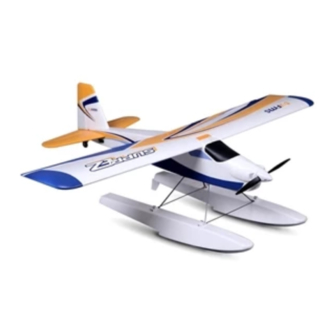
Summary of Contents for FMS 1220MM Super EZ V2
- Page 1 1220MM Super EZ V2 FMSMODEL.COM FLOAT RIGID STABLE Float included Durable EPO SMOOTH FLYING PERFORMANCE...
- Page 3 WARNING: Read the ENTIRE instruction manual to become familiar with the features of the product before operating. Failure to operate the product correctly can result in damage to the product,personal property and cause serious injury. This is a sophisticated hobby product and NOT a toy. It must be operated with caution and common sense and failure to do so could result in injury or damage to the product or other property.
-
Page 4: Table Of Contents
······················································································································17 Introductions Behold the FMS Super EZ trainer! FMS is very proud to present one of the most advanced multi-purpose trainers on the market today, the Version 2 Super EZ . Featuring cool looks, 1.2M wingspan, low wing-loading, super-light construction and metal landing gear, the Super EZ has great trainer aircraft flight characteristics! No need for electronic stabilization or advanced transmitters, the Super EZ allows for very easy smooth flights. -
Page 5: Contents Of Kit
Wingspan: 1220mm (48.0in) Overall Length: 1020mm (40.2in) Flying Weight: Around 920g(31.4oz),1120(39.05oz) Motor Size: Brushless 3136-KV1230 Wing Load: 31.34 g/dm² (0.07oz/in²) Wing Area: 28.4 dm² (440.2sq.in) ESC: 20A Servo: No Float 9g Servo x 4, Float Included Servo x 5 Recommended Battery: 11.1V 1300-2200mAh 25C Contents of Kit Before assembly, please inspect the contents of the kit. -
Page 6: Model Assembly
Model Assembly Main Wing Installation Unpack the assessory bag of rudder, which includes servo arms , screws, linkage rods (including clevis and sleeve). Install the servo arms as shown in Figure 1. Install the linkage rod as shown in Figure 2. Pay attention to the direction of the servo arm. - Page 7 Model Assembly Main Wing Installation Fix the landing gear set with the screw, as shown in Figure7. Find the Y-harness and connect it to both aileron servos. Connect the Y-harness to the receiver, then place the receiver into the fuselage. HKM 3.0*10 fig7 fig8...
- Page 8 Model Assembly Floats Set Installation: 7. Assemble the floats struts to the plastic part as shown in Figure 11 and secure the struts with screws. Screws 3*4 fig11 8. Fix the floats set with struts on the bottom of fuselage with screws as shown in Figure 12. HKM 3.0*10 fig12...
-
Page 9: Battery And Radio Installation
Battery and radio installation 1. Apply the hook tape to the cable end of the battery.(fig 13) 2. Slide the battery into the battery hatch with the power supply cable toward the rear end of the plane and the hook tape facing the bottom of the battery hatch. Note: You may need to relocate the battery position to acheieve the correct CG for your model. -
Page 10: Important Esc And Model Information
Get your model ready to fly Important ESC and model information The ESC included with the model has a safe start. If the motor battery is connected to the ESC and the throt- tle stick is not in the low throttle or off position, the motor will not start until the throttle stick is moved to the low throttle or off position. -
Page 11: Check The Control Throws
Check the control throws The suggested control throw setting for FMS MODEL are as follows (dual rate setting): Elevator 15mm up/down 10mm up/down Aileron 15mm up/down 10mm up/down Rudder 12mm left/right 8mm left/right Tips: On first flight, fly the model in low rate. The first time you use high rates, be sure to fly at low... -
Page 13: Install The Propeller Set
Secure the spinner base a, propeller b, spinner plate c to the motor one by one. Fix the propeller with spin- ner cap d as the given spinning direction below. Check the C.G. (Center of Gravity) When balancing your model, adjust the motor battery as necessary so the model is level or slightly nose down. -
Page 14: Before Flying The Model
Before flying the model Find a suitable flying site Find a flying site clear of buildings, trees, power lines and other obstructions. Until you know how much area will be required and have mastered flying your plane in confined spaces, choose a site which is at least the size of two to three football fields - a flying field specifically for R/C planes is best. -
Page 15: Flying Course
Flying Course Take off While applying power, slowly steer to keep the model straight. The model should accelerate quickly. As the model gains flight speed you will want to climb at a steady and even rate. It will climb out at a nice angle of attack (AOA). -
Page 16: Trouble Shooting
Trouble shooting... -
Page 17: Spare Parts List Content
Spare parts list content FMSPH101-1 Fuselage FMSPH102 Main Wing FMSPH103 Horizontal Stabilizer FMSPH104 Cowl FMSPH105 Battery Cover FMSPH106 Spinner FMSPH108 Front Landing Gear Set FMSPH109 Tire set FMSPH110 Wing Bolt Plate FMSPH114 Sticker FMSPH115-1 Linkage Rods FMSPH116-1 Screws FMSPH117 Pipe FMSPROP022 Propeller FMSDJ009... -
Page 18: Esc Instruction
ESC instruction Brushless Speed Controller A quality connector Battery is essential Pack Motor Brushless Controller Receiver...

















Need help?
Do you have a question about the 1220MM Super EZ V2 and is the answer not in the manual?
Questions and answers